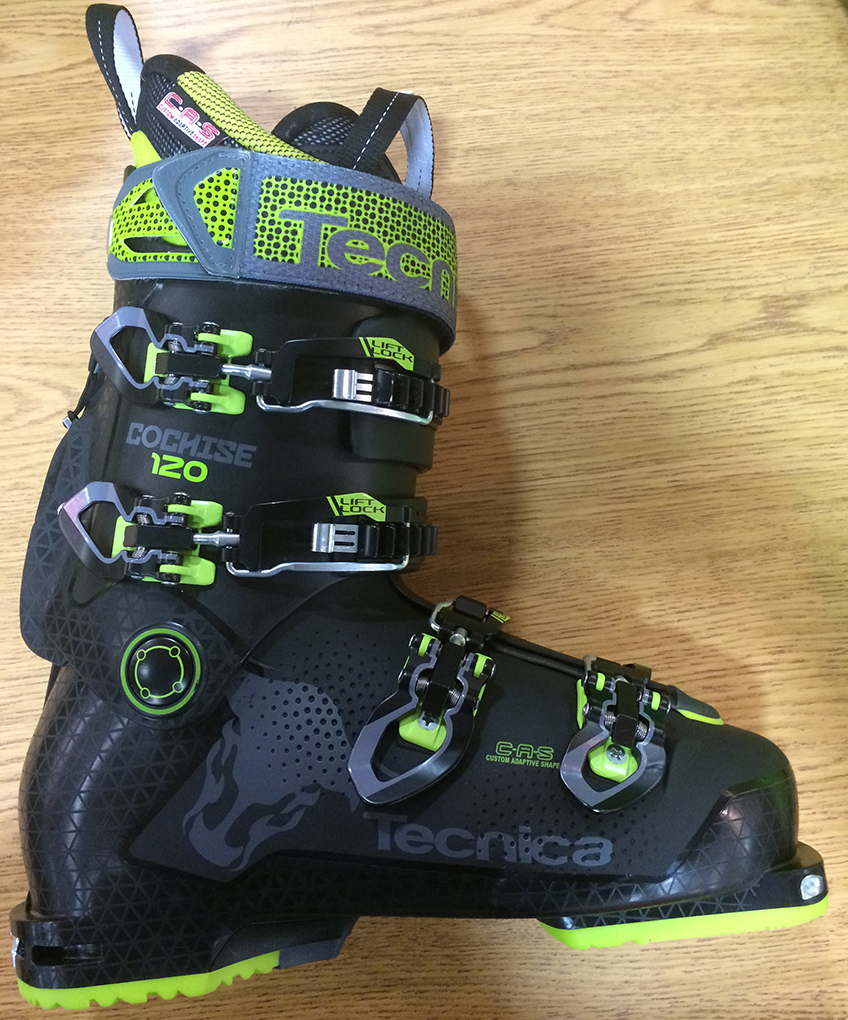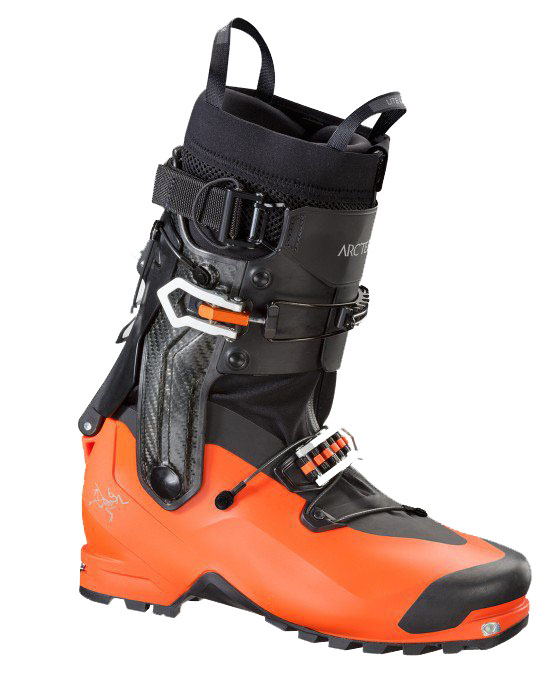With the new year comes new product announcements, and there is no question that in the world of skiing right now, the hottest category is the ever-growing alpine touring boot segment.
For a more detailed breakdown of the different types of touring boots (and the bindings they are compatible with), check out our AT Boots and Bindings 101 piece.
Here are a some of the most notable new designs:
Dynafit TLT7
Dynafit kind of wrote the book for lightweight AT boots with the TLT5 and 6. For 2017, they build on that legacy with the TLT7.

At first glance, the lack of a toe welt is the most noticeable feature of the new boot. Omitting the welt allowed Dynafit to shave weight and move the pivot point in toward the ball of the foot for more efficient touring.
The TLT7 also features a single buckle / cable system that controls the walk mode, the cuff buckle, and what would usually be the lower midfoot buckle, as well as a redesigned tech fitting that looks like a natural evolution of Dynafit’s quick-step inserts.
The TLT7 will feature a higher-volume fit than the TLT6, but will not be compatible with Dynafit’s Beast bindings, and will require a 36 g/pair adaptor from Dynafit to work with automatic crampons, since it lacks that toe welt.

Dynafit claims that the TLT7 was built with downhill performance in mind, and that it will ski better than the TLT6 series, while still weighing in at a stated 999 grams in a 27.5 for the high-end “Performance” version.
Tecnica Zero G Boot
Tecnica is introducing a completely new “Zero G” line of boots for 16/17. They feature a totally new construction, a new liner, and a new fit that will feature a snugger heel hold with a roomier, 99 mm last.

The Zero G line has a bi-injected construction that employs a different type of plastic for the sole and part of the lower of the boot which is stiffer and stronger by weight than Tecnica’s typical shell material. This allows Tecnica to make this portion of the shell (that doesn’t affect the flex of the boot) thinner and lighter.
The Zero G line will be available in in three flavors: the 130 flex Guide Pro; the 110 flex Guide; and the 105 flex women’s version, with the Pro coming in at a stated 1545 grams in a size 26.5.
(Hmmm, isn’t there some other AT boot that comes in at exactly 1545 grams in a 26.5?)
Tecnica Cochise
In addition to the Zero G line of boots, Tecnica has also updated their successful Cochise series with a new liner and buckles, as well as the new bi-injected construction found on the ZeroG.

While the Cochise is still being marketed as a versatile 99mm-lasted, downhill-oriented boot, the 2017 model weigh in around 1850 grams and features an impressive 42-degree range of motion.
Arc’teryx Procline
Arc’teryx’s new Procline touring boot looks to be a very interesting addition to the lightweight AT boot category.

In addition to their innovative lateral walk mode, the Procline also will feature a built-in zip gaiter, and a stated weight for the size 27.5 of 1190 g in the most expensive “Carbon Lite” version. We’re looking forward to getting into the Procline and comparing it to boots like the Atomic Backland Carbon.
K2 Pinnacle Pro
New for 16/17, K2 has added the 100mm last Pinnacle Pro to their previous Pinnacle line of boots. The Pinnacle Pro still features both tech fittings and din soles, so it should be compatible with just about every binding available.

The Pinnacle Pro will have optional rockered touring soles available, and (most importantly) reportedly shaves 300 grams per boot off the current Pinnacle 130, which would make it much more competitive weight-wise with the current crop of lighter, hard-charging AT boots.
Salomon MTN Explore W
It’s no secret that we’re fans of both the Salomon MTN Lab and its lighter and softer-flexing sibling, the MTN Explore. But for ladies looking for a boot that goes up and down well, the options have been fairly slim..
But there is some potentially good news on the horizon: for 16/17, Salomon is introducing the MTN Explore W, a women’s-specific version of the MTN Explore.

It features a stated 90 flex, and the same layout and construction as the Men’s MTN Explore.
Of course, we don’t hand out “Best New Product” awards from the carpeted floors of convention centers (because that’s still stupid), but we do look forward to getting all of these products on snow and seeing what they can actually do.

So what’s the intended use of the Guide Pro vs the Cochise? Basically looks like a lighter cochise with a bit different fit? Same range of motion? Does it replace the cochise pro lights?
Kinda sad to see the 4 buckles vs the 3 and the buckle strap.
Zero G boot is targeted at someone who wants to spend more time in the backcountry. It is designed to be light, light, light yet provide better downhill performance than any other boot in it’s weight class. Lighter plastic, lighter liner, lighter buckles, and rockered sole come standard.
The Cochise series is injected in PE and PU. Plastics commonly found in race and true high performance boots and not lightweight touring boots. Yet with the new Power Light Design you can have a full PE plastic boot weigh in at 1850g. The Cochise Pro 130 from 15/16 weighs 2250g in lightweight Triax plastic for reference. Cochise and Zero G come out of the same mold however the Cochise has a slightly high spine and has 2* less Rearward ROM. With a higher spine, heavier buckles, DIN/tech standard, a more traditional ski boot liner (CAS) and PE plastic, the Cochise is targeted at someone who values performance over weight and truely wants one boot to shred in bounds all day yet maybe take a few laps out the gates.
Right, so as I suspected the Zero G sounds like it takes place of the Cochise Pro Light. Or rather what the Pro light SHOULD have been.
Any pics of the Zero G liner? Info on the Carbon Lupo TI? I heard Salomon is already making big changes, or a different version, to the MTN Lab boot…
Worth noting that the picture of the TLT7 is of the Carbonio version, which will be limited to a select group of retailers.
You have a photo of the stock grey option? More specifically how the new ultra lock system works?
Will salomon offer 2 soles for the Mtn lab next year like scarpa does?
Hey Cy! Do you have any thoughts on the TLT7 crampon adapter? At first glance it seems like a stand-in fix for a self-created difference. The TLT5/6 and the PDG are some of the best ski mountaineering boots because of their flexibility and crampon compatibility and the new TLT7 toe now presents some potential challenges to ski mountaineering use or at the very least requires users to upgrade another piece of their system.
Specifically I’m curious to see how easy (or not easy) the adapter is to put on and take off crampons. Looks like a simple hex bolt that tightens onto the existing toe bail, which theoretically means it’ll be easy enough to switch between crampons at home, but might cause some issues in the field. Given that the rest of the features on the TLT/PDG series already make them excellent climbing boots, doesn’t seem like a huge issue unless the rounded toe results in a little more play in the crampon attachment. One of the best things about having a pair of automatic crampons fit the TLT’s is that the connection is so solid for climbing ice or mixed during an ascent. Could potentially cause issues with needing to carry multiple pairs of crampons too if the adapter isn’t super easy to swap out.
Regardless of the outcome, the omission of the toe welt is certainly a new development and direction in design and I’m excited to see how it pans out in actual use.
Hey Matt!
Unfortunately I didn’t get to fondle the actual adapter, just the catalog pic you see there.
Your comment basically exactly mirrors my concern with this boot. That attachment, as explained to me, is just a simple hex bolt like you said. Personally if I’m in a situation where I’m about to need crampons, I have absolutely no desire to fumble around with anything – or potentially lose tiny pieces. So while you probably *could* swap that adapter out in the field, that just sounds like a recipe for disaster to me. Just looking at it it seems like it’s the sort of thing you would put on at the beginning of the season and not really take off/swap out that often.
As far as play, that seems like a potential issue, and I’m interested in hearing real-world feedback once the boot is available. Maybe it’s super secure….
As far as the “climability” of the TLT7, that’s been on my mind since I first saw pictures of it. The rounded toe is probably better for rocky scrambling where you wouldn’t be wearing crampons anyway. However, even for just steep bootpacks, the kind of thing where you probably don’t need crampons, but you are kicking steps (skiing couloirs in decent snow for example) I’m interested in seeing how this boot stacks up. I know I rely on that toe welt to kick steps in lots of situations, especially when I’m on something where I don’t need crampons but I hit a patch of firmer snow.
Dynafit really seems to be focusing on the more natural stride created by having the tech fitting in closer to the ball of the foot, as well as talking about how well the boot skis.
This is just pure conjecture on my part, but my impression so far is that the TLT7 is better suited for someone who is focused on skiing a lot of vert, but maybe not in such nasty, mountaineering conditions, where a boot like the Backland Carbon, or the new Procline would shine. Again, purely conjecture, but I’m excited to see how the TLT7 stacks up against those options — and the old TLT6.
If the goal was just the better stride then why did they not just left the toe welt on the boot and moved back the insert anyways?
Ah, nevermind: the insert has to be close to the frontmost part of the boot or else there will be troubles with clearance from the binding/ski when walking…
Any plans to add the Lange 130 XT Freeride to the list and any plans for a review?
Yep. Testing begins next week…
Sweet! currently switching between the RX 130 and 130 XT hoping the XT freeride will let me consolidate boots and lose some weight in the process.
Have you gotten your hands on 2017 salomon quest line up?
Any Idea when the Salomon QST boots will be available?
what about the dynafit kihon/beast boot???
We’ve been waiting for Dynafit to get that boot dialed in…
Do you know if the cochise 120 actually does come in a size 22.5 as per the Technica website?
Sad to see Tecnica bailing out on us guys who possess a wide forefoot.